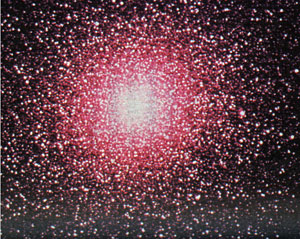- Department of Physics
- Observatory
- PHYS 162H Honors Project
- Star Clusters
Physics 162H Honors Project: Star Clusters
 Star Clusters are an easily recognizable group of distant stars which consist of anywhere from a few dozen to a million stars in a region only a few parsecs across. It is believed that this proximity is due to the stars' formation from the same medium under the same conditions. All the stars in a cluster are usually about the same age. These stellar assemblies are held together with gravity.
Star Clusters are an easily recognizable group of distant stars which consist of anywhere from a few dozen to a million stars in a region only a few parsecs across. It is believed that this proximity is due to the stars' formation from the same medium under the same conditions. All the stars in a cluster are usually about the same age. These stellar assemblies are held together with gravity.
There are two basic types of clusters. The first is the Open Cluster, in which the stars are very dispersed and not packed tightly together. These types of clusters are typically found in the Milky Way and contain only a few hundred to 100,000 stars. Commonly, these are also called Type I or younger clusters, and these contain young blue stars of the O and B types.
The second type is a Globular Cluster. This is a kind of stellar swarm or cascade of closely packed stars that resembles an explosion of stars frozen in the process. All of these beautiful stellar objects are roughly spherical and typically contain tens of thousands, sometimes millions, of stars. They average 50 pc in diameter. Globular, or type II, clusters seem to completely lack O and B type stars, and the blue stars visible are stars that are off of the main sequence or the product of the fusion of two older stars. This indicates an older collection of stars. Most Globulars are a great distance from Earth, often lying outside the galactic plane. They are sometimes referred to as Halo Clusters when talked about in this fashion. The spectra of these clusters also show a lack of heavier elements, also suggesting that these stars are of an older generation from a time when heavier elements were less abundant. It is thought that globular clusters are remnants from an earlier stage of our galaxy's evolution.
For this project, a collection of both types of clusters is required. An HR diagram of the stars is of use to you, as it verifies everything which is have included in the above paragraphs. There are a number of such HR diagrams in your textbook.
Procedure
- Devise a plan of attack. Consult with the observatory manager and choose the objects you wish to try to view through the telescope. Messier objects are the most likely to be found, so it is strongly recommended that you stick to the Messier Catalog. It is also recommended that you choose objects visible in the Northern hemisphere. Find coordinates for your desired objects. For this project, there are several recommended objects, which are:
-The Pleiades (7 Sisters) Star Cluster.
- M-13 Star Cluster in Hercules.
- The Double Cluster in Perseus.
- The Beehive Cluster in Cancer.
- M-3 near Ursa Majoris.
- The Double Cluster in Perseus - Locate each object the telescope at Davis Hall.
- With the manager's assistance, attach either a camera or the CCD to the scope. An option for a very faint cluster is to observe it visually and attempt to sketch a picture.
- Capture at least one image, or more if you choose. Try several different images in different scopes and powers of magnification.
- With use of photography, or with the CCD images, the pictures may be enlarged so that they may be more visible. For the stars, it is enough to observe their color differences and brightnesses. You probably won't need a picture, though they could be a nice addition to the report. If the stars in a cluster are of the same overall color, be sure to note this.
Data Interpretation
For the most part, data interpretation will be difficult for this project. You will be able to tell the difference between star clusters easily, but the colors of the stars may be elusive and deceiving. As such, you will be required to extrapolate a little. Several pictures included in the report will be useful.
Observatory Manager
Jeremy Benson
jjbenson@niu.edu
Location
Davis Hall Room 703Normal and Locust Roads
DeKalb, IL 60115Google Maps